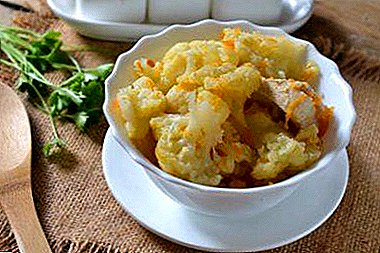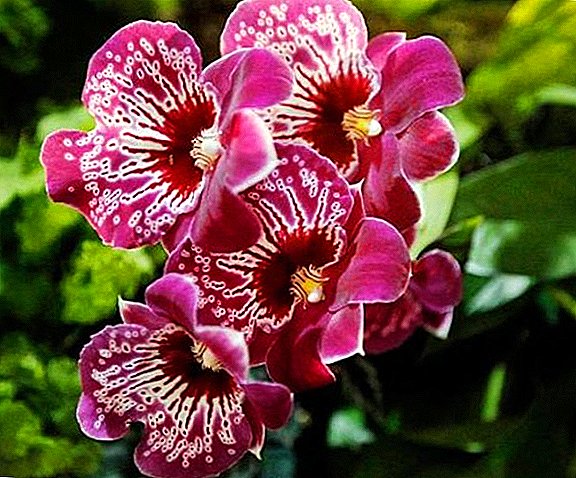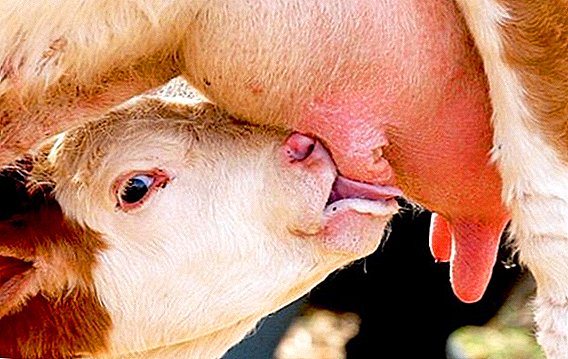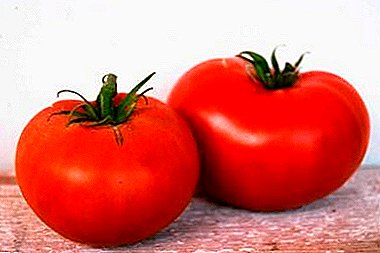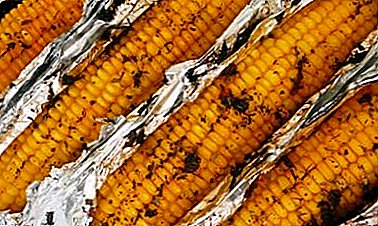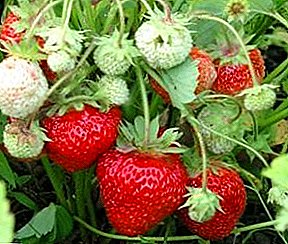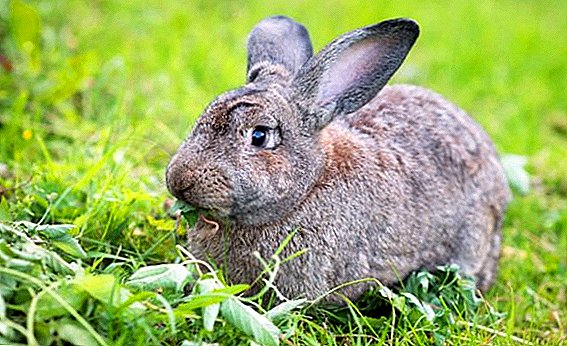 If you look at the photo of a rabbit with the funny name "Soviet Chinchilla", there is no doubt where the second word in the name of the breed comes from. The fur coat of these animals really very much resembles the fur coat of the most valuable fur animal (good, at least once in a life, everyone has seen a chinchilla in a pet store). The main value of rabbits of this breed is precisely fur. Well, and they are also grown for ornamental purposes, which also makes the breed with a fur "namesake". About why the word "Soviet" was added to the chinchilla, it will be clear to anyone who wants to ask about the breeding history. But first things first.
If you look at the photo of a rabbit with the funny name "Soviet Chinchilla", there is no doubt where the second word in the name of the breed comes from. The fur coat of these animals really very much resembles the fur coat of the most valuable fur animal (good, at least once in a life, everyone has seen a chinchilla in a pet store). The main value of rabbits of this breed is precisely fur. Well, and they are also grown for ornamental purposes, which also makes the breed with a fur "namesake". About why the word "Soviet" was added to the chinchilla, it will be clear to anyone who wants to ask about the breeding history. But first things first.
Breed description
Today, the Soviet chinchilla is one of most popular rabbit breeds due to its simplicity and versatility. They equally well play the role of a pet and a prolific and caring mother, moreover, no matter how cynical it sounds, they have very tasty meat, as well as exceptionally beautiful, and most importantly, fur very similar to the more valuable fur-bearing animal. 
Important! The similarity of the skin of this eared beast with a chinchilla is so great that some particularly impudent businessmen even manage to sell products from it to unlucky young ladies under the guise of incomparably more expensive chinchilla. To avoid the opposite happen to you, buying a chinchilla fur coat, make sure that this is not a Soviet rabbit!
Inference history
As you might guess, the breed was bred in the Soviet Union. Breeding work began in the late 20s of the last century and officially ended in 1963.
I must say that the rabbits of this breed were known for a long time, the main merit of Soviet breeders is that they managed to breed larger animals, retaining all the valuable characteristics of their predecessors.
Initially similar to the chinchilla rabbits were bred in France, called them small or medium chinchilla. The animals had a weight of about 2.5 kg. It was these rodents that were brought to the USSR about 90 years ago and were taken into serious "turnover".
Did you know? The most valuable breed of rabbits in the world is the Fold American Holland lop. The price of one individual is on average one thousand American dollars.
Around the same time, when a small chinchilla was bred in France, the Belgian breeders presented the world with a new breed of rabbits - the white giant, which by more than twice its body weight was greater than its French counterparts. At the same time, white eared animals also had very good fur in quality and appearance characteristics, as well as tasty meat.  The white giant was brought to the Soviet Union almost simultaneously with the chinchilla, but I must say, it got accustomed badly. Harsh Russian conditions are not suitable for gentle animals, they died en masse. So the selection work with this material was in some sense a necessary measure. But she gave an excellent result.
The white giant was brought to the Soviet Union almost simultaneously with the chinchilla, but I must say, it got accustomed badly. Harsh Russian conditions are not suitable for gentle animals, they died en masse. So the selection work with this material was in some sense a necessary measure. But she gave an excellent result.
Crossing the French babies with the Belgian giants, lengthy experiments and the hard work of Saratov and Novosibirsk breeders eventually led to the creation of a new hybrid that absorbed an amazing chinchilla color, the ability to survive in a fairly cold climate and quite impressive size, which is especially valuable as in terms of skin, and in terms of meat.
Rabbit breeders will be interested in reading about rabbit breeds: Californian, Angora, butterfly, gray giant, rizen, flandr.
External characteristics
Distinctive features of this breed are:
- thick and very soft fur of a beautiful silver-blue hue;
- black bezel on the tip of the tail and on the contour of the ears;
- brown eyes with a cherry tint and light contour, at least - blue;
- upright ears, not very large compared to the body;
- the constitution is strong and compact, with an average length of 65 cm, the bones are well developed, the back is elongated, slightly rounded, the head is small, and the chest, on the contrary, is wide and powerful, with an average girth of 40 cm;
- legs are straight and powerful, with excellent musculature;
- The body weight of an adult individual varies from 5 to 8 kg, depending on the conditions of detention.
 A few more words about the fur cover. The rich appearance of the wool of these animals gives a variety of every hair. Bluish along the main length, it has a dark ending. If you blow on such a coat against the direction of its growth, several shades from undercoat to tips are very well seen - blue, black, white and gray.
A few more words about the fur cover. The rich appearance of the wool of these animals gives a variety of every hair. Bluish along the main length, it has a dark ending. If you blow on such a coat against the direction of its growth, several shades from undercoat to tips are very well seen - blue, black, white and gray.In general, the color looks like an uneven overlapping of several patterns on one another, with light flowing on the back of the head, on the abdomen, in the lower part of the legs and tail, and darker on the back and sides.
Important! As you know, rabbit fur is very short-lived. However, among their fellows, Soviet chinchillas stand out for their wool of very high thickness, only a black-brown rabbit very similar to a black chinchilla can compete with them. However, the white giant also participated in the selection of this species, and attention! - a real chinchilla.
When describing this breed, they always note large sizes, valuable fur, endurance and resistance to cold climates, unpretentiousness in feeding and, moreover, Soviet chinchillas grow very quickly and actively reproduce.
Productivity
Indeed, the breeding of the Soviet chinchilla is interesting only by the fact that these rabbits, thanks to their stamina and large size, are champions of productivity.
In one litter, usually seven or eight cubs are born that start to gain weight extremely quickly: having a birth weight of less than 100 g, in the first two months of life, rabbits increase it two and a half times, by three months their weight rapidly approaches 3 kg, for the next month another kilogram is added, etc. In addition, each additional kilogram of animal weight costs the breeder only 3-4 kg of feed.
Rabbits of this breed also have a very good lactation: each female can give her offspring up to 200 g of milk per day!
The “wastelessness” of production mentioned above when breeding Soviet chinchillas reaches 63% by 4 months: this proportion of live weight of the animal is used only in the form of meat, and in the remaining 37% there is a weight of an even more valuable skin! 
What to look for when buying
When buying a purebred animal, you need to pay attention to two points: documents and appearance. And both are equally important.
On the one hand, without properly decorated papers, it is impossible to say with confidence that the valuable Soviet chinchilla, and not the usual gray rabbit, is in front of you (the animal’s fur shimmering in different shades does not appear immediately, the animal should be drained at least once, in the absence of sufficient experience of the breeder, it will not be difficult to mislead him with sweet speeches for fraudsters).
On the other hand, as the hero of the Soviet anecdote said, they hit not with a passport, but with a face, therefore, no matter what seals and emblems tribal papers were decorated, if their “owner” looks half-dead and miserable, documents are unlikely to save him from death, and you - from inevitable losses.
Important! Beginner breeders should pay attention to adults, since young animals are less pronounced main external characteristics of the breed, which means you can become a victim of deception. Another option is to buy from a well-trusted seller.
Looking at the animal, pay attention to the following points:
- in a healthy animal, the eyes are clean and shiny, the body is strong, the coat is thick and fluffy;
- the rodent should behave actively, have a well-fed and satisfied life;
- The coat should have a characteristic silvery shade - lighter in the lower and darker in the upper part of the body, on the ears and tail is a dark outline, there are white spots under the eyes, and to the touch the fur is thick and very pleasant.

Maintenance and care
Care for representatives of this breed is relatively uncomplicated, since animals are unpretentious, hardy and specially bred for breeding in our latitudes.
For the maintenance of animals, you can use the usual rabbit or cells, as well as more "advanced" sheds.
Important! The shedding system for breeding rabbits involves the installation of cells in blocks, usually in several tiers, between which there is a passage, thus it is very convenient to organize an automated feed and water supply system, as well as cleaning the cells and monitoring the condition of the animals. Such a system doubles productivity, allowing one employee to easily control the content of one and a half hundred adult animals and more than a thousand young.
Nevertheless, it should be understood that the unpretentiousness of the Soviet chinchilla is estimated in comparison with other breeds of eared rodents, however, in general, these animals are known to be capricious enough and demanding conditions of detention. In particular, extreme weather conditions (both toward the cold and toward the heat) are a clear reason to show maximum attention to their pets.
The temperature in the rabbit farm in summer should not rise above + 25 ° C, and in winter fall below + 5 ° C (the norm is + 15 ° C). In principle, the Soviet chinchilla can survive at colder temperatures, but in this case, you need to make adjustments to the power system, increasing its caloric content by about 15%.
As with any farm animal, rabbits are very sensitive to cleanliness, so the litter needs to be changed regularly, ensuring its dryness and freshness.
Learn how to use rabbit manure in agriculture.
It is also important that there are no drafts in the rabbitry. Of course, animals should be protected from the bright and hot sun and, finally, they should be properly fed and have constant access to clean water (and in winter you need to make sure that the water is slightly warmed up and not cooled in any way). 
What to feed
Rabbit food must be properly balanced and include the following mandatory components:
- fresh greens, skin of vegetables and fruits. From such food, the body of the rodent gets fiber, necessary for the normal operation of the digestive system and intestines;
- vegetables and silage (succulent feed), especially in winter, when the amount of fresh greens is limited;
- roughage, also a source of fiber and, in addition, vitamins, minerals and protein. This is primarily hay, as well as twigs, straw and grass meal;
- concentrated feed. In addition to animal feed, this group also includes various cereals and legumes, for example, corn, oats, barley, rye, wheat, peeled peas, lentils, soybeans, beans, carnival waste, meat and bone meal and fish meal.
In addition to these components, vitamins and minerals should be added to the diet of Soviet chinchillas (in particular, for this, animals are given chalk and table salt).
Important! The formation of the diet of rabbits should be approached very seriously, because their digestive system categorically does not absorb a huge amount of seemingly absolutely harmless plants and products (for example, iceberg lettuce, red cabbage, honey, sugar, tomatoes, mushrooms, etc.). The list of banned products should be studied and taken into account in order not to lose all livestock overnight.
In addition, the rabbit feed should always be clean and fresh, so you should not give it too much so that the animals do not scatter it on the litter. 
Vaccinations for rabbits
Vaccination is by far the most effective way to prevent the most dangerous diseases in both humans and animals. Rabbits are no exception.
For the treatment of rabbit diseases, such drugs as Tromeksin, Enrofloxacin, Enroxil, Nitox 200, Loseval, Baytril, Biovit-80 are used.
The main enemies of these animals are myxomatosis, a viral disease arising and occurring at the speed of lightning and practically incurable, and a viral hemorrhagic disease (abbreviated as VGBK), which is also almost 100% fatal. Both of these diseases are also dangerous to humans.
They can not be cured, but you can insure. To this end, at the age of one and a half months, the rabbit is given the first, and after three months - a second vaccination. In subsequent vaccinations are repeated annually throughout the life of the rodent.
Did you know? The opinion among rabbit breeders that rabbits do not suffer from rabies is not true. In the North American United States, there have been cases in which rabid raccoons have penetrated rabbitries and infected livestock.
Therefore, taking into account the frequent facts of the appearance of rabid foxes within the boundaries of settlements, as well as dogs and other animals, and given that there is no other salvation from this disease, except for timely vaccinations, there is no need to lose vigilance. However, the decision remains for the breeder, since it is still not accepted to vaccinate rabbits for rabies in our country.  It is possible that under normal conditions a normal precautionary measure will be a strong fence in front of the rabbit, but it should be borne in mind that appropriate vaccination will have to be done to transport the animal abroad, without it crossing the state border is officially impossible.
It is possible that under normal conditions a normal precautionary measure will be a strong fence in front of the rabbit, but it should be borne in mind that appropriate vaccination will have to be done to transport the animal abroad, without it crossing the state border is officially impossible.
To save the livestock of rabbits from coccidiosis help drugs "Solikoks" and "Baykoks".
Rearing
All the above breed advantages can be provided and maintained only with strict observance of cleanliness of the lines, any presence in the genus of "grandmother who sinned with a diver" can lead to the fact that ease of maintenance, beautiful fur and other characteristics of eared livestock will come to naught. In addition, when breeding, you should try to avoid closely related crosses, otherwise the young will be born weak and unfit for breeding work. Therefore, a novice breeder needs to acquire females and males with no coinciding ancestors at least in the next two generations.
Crawls are not monogamous animals, so for ten females it is enough to purchase one or two males. Healthy offspring is provided subject to crossing individuals that have reached at least six months of age.
The fecundity of rabbits is a well-known fact, but Soviet chinchillas are leading even among their fellows.
Did you know? The rabbit's pregnancy lasts about a month, but the animal usually does not bring more than five litters a year. With the above-mentioned average number of rabbits in a litter, it is easy to calculate that good care can increase the population in the rabbit by forty individuals per year from only one rabbit. In fairness, the number thirty is more real, but that’s not bad at all!
After a month and a half after the birth, the rabbits are deposited in a separate cage, and the young go on to independent feeding. A good option for baby food are dandelion leaves, hay and concentrated feed, pre-chopped.  When rabbits reach two months of age, they are separated by gender and kept separately, in order to avoid premature mating. That is, in fact, all wisdom.
When rabbits reach two months of age, they are separated by gender and kept separately, in order to avoid premature mating. That is, in fact, all wisdom.
Soviet chinchilla is a great option for a beginner rabbit breeder. However, the success of the event in the first place depends on whether you can purchase purebred representatives of the breed, since, as was said, only breeding animals meet the stated characteristics.
Do not be fooled, and the Soviet chinchilla will delight you with its endurance, unpretentiousness and fecundity, as well as high-quality meat and beautiful fur!



